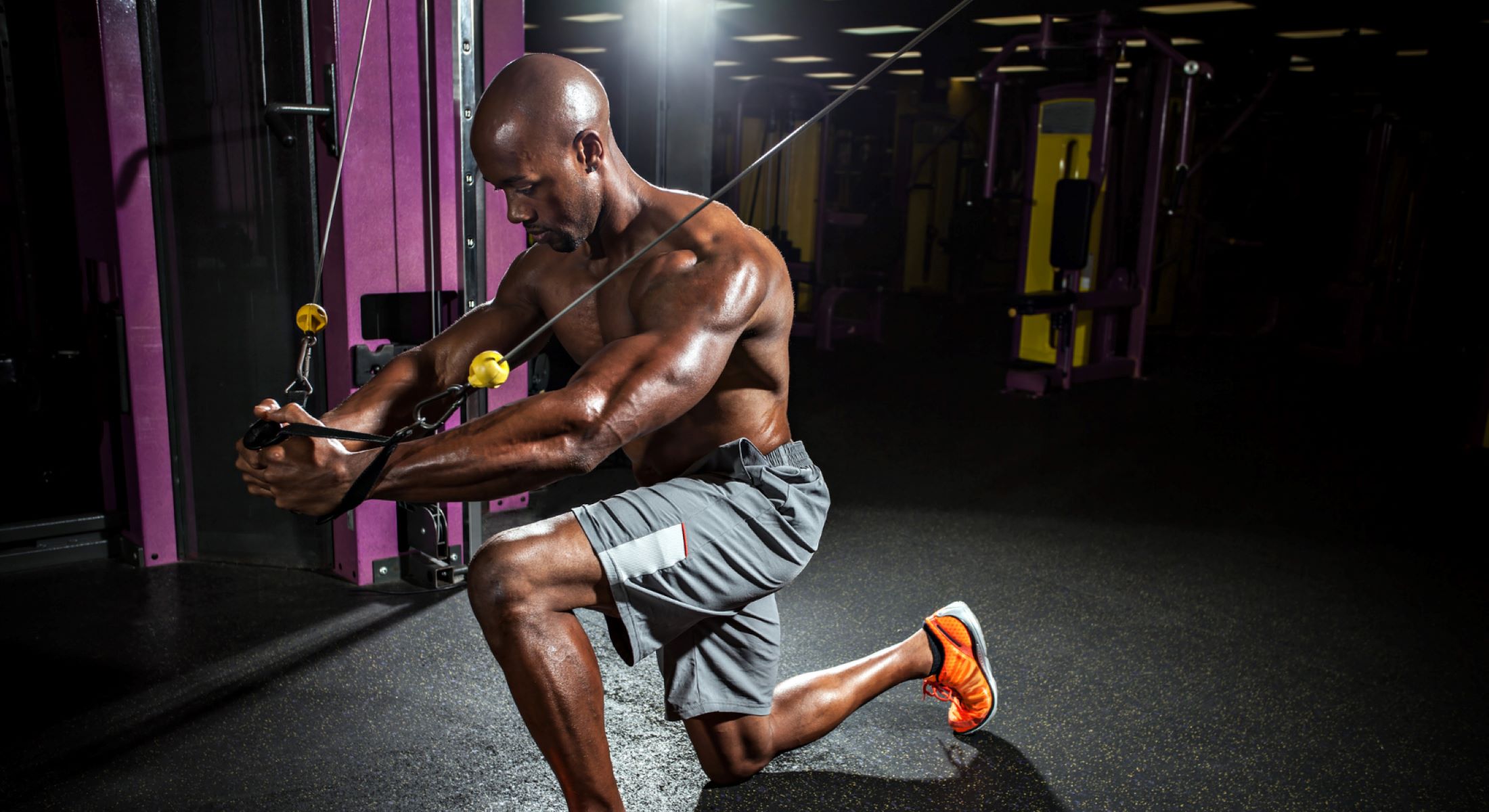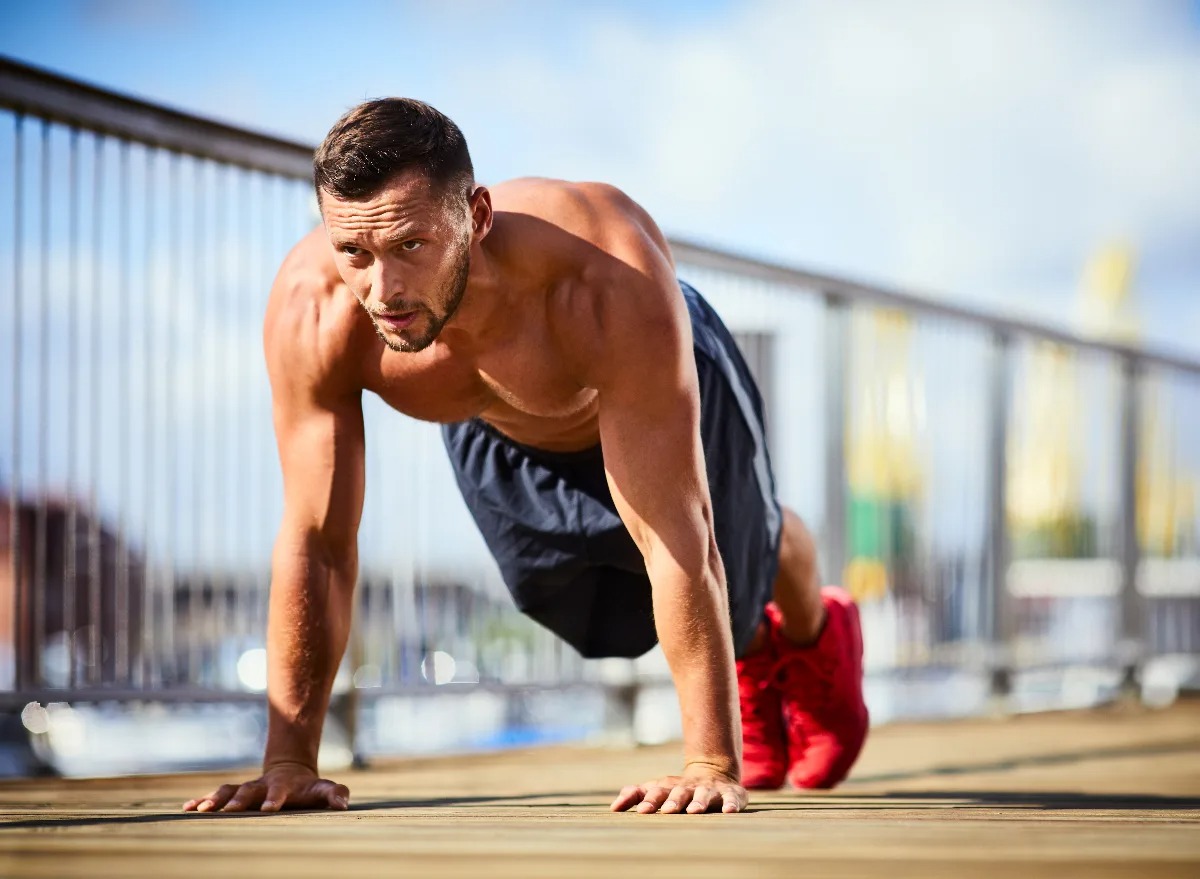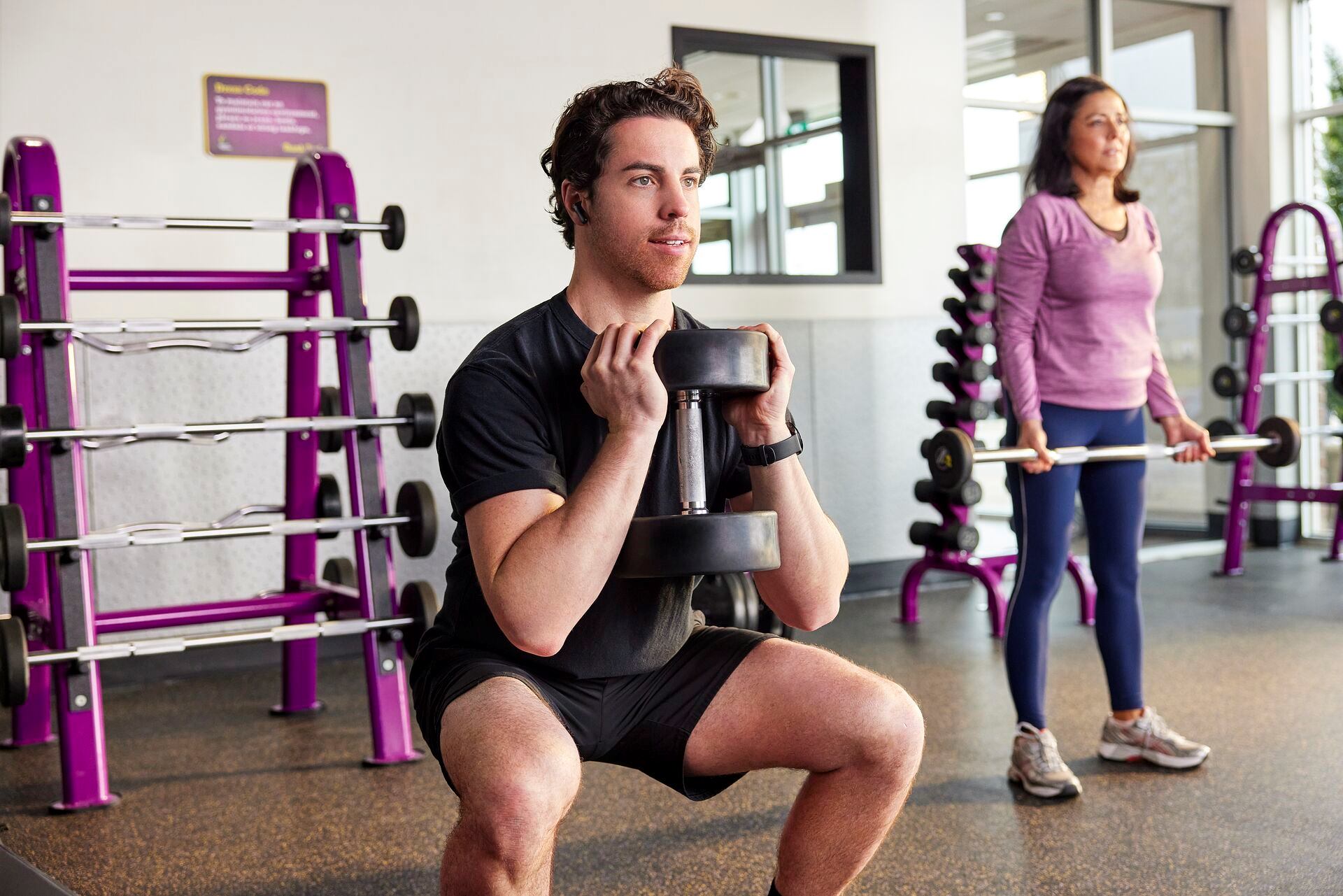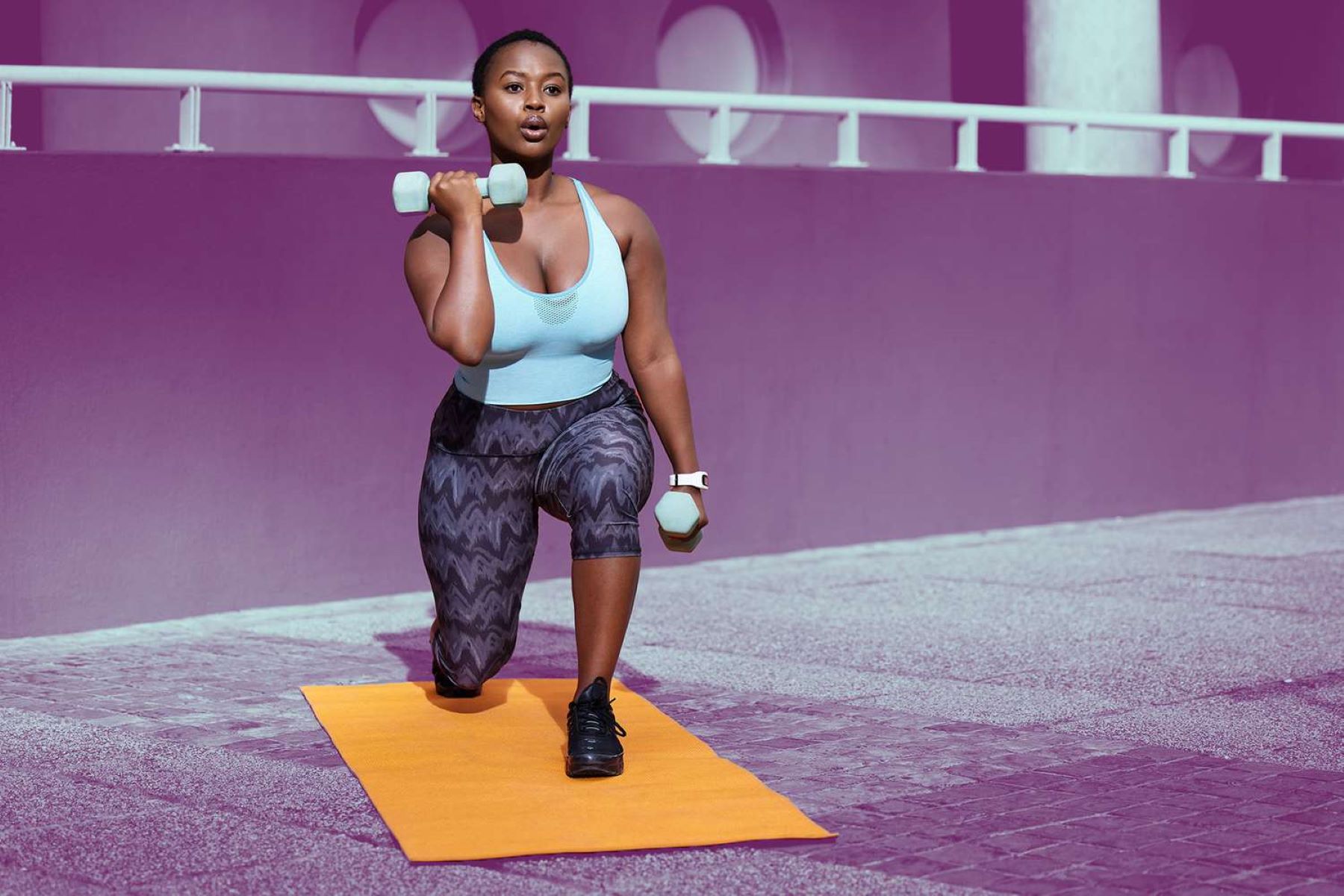Home>Misc>Featured>Which Type Of Exercise Improves Cardiovascular Fitness?


Featured
Which Type Of Exercise Improves Cardiovascular Fitness?
Modified: August 22, 2023
Discover the featured exercise type that effectively enhances cardiovascular fitness and boosts overall health. Find out how to improve your heart health today.
Introduction
When it comes to improving cardiovascular fitness, exercise is key. Engaging in regular physical activity not only strengthens your heart and lungs but also improves overall health and well-being. Cardiovascular fitness, also known as aerobic fitness, is the ability of your body to efficiently transport and utilize oxygen during exercise.
The benefits of cardiovascular fitness are numerous. It helps to lower the risk of chronic diseases such as heart disease, stroke, and diabetes. It also enhances lung capacity, increases energy levels, aids in weight management, and boosts mood and mental health. Whether you’re a beginner starting your fitness journey or a seasoned athlete looking to improve your performance, there are various types of exercises that can help you achieve your cardiovascular fitness goals.
In this article, we will explore different types of exercises that are known for their effectiveness in improving cardiovascular fitness. From traditional cardio exercises to high-intensity interval training (HIIT) and fun activities like dancing, we will discuss the benefits and considerations for each. Whether you prefer indoor or outdoor activities, there is a wide range of options available to suit your preferences and fitness level. So, let’s dive in and discover which type of exercise can best improve your cardiovascular fitness.
Benefits of Cardiovascular Fitness
Engaging in regular cardiovascular exercise offers a multitude of benefits for both your physical and mental well-being. Here are some of the key advantages of improving cardiovascular fitness:
- Improved Heart Health: Cardiovascular exercise strengthens your heart muscle, making it more efficient in pumping blood and delivering oxygen to your muscles and organs. It also helps lower blood pressure and reduces the risk of heart disease.
- Increased Lung Capacity: Regular aerobic exercise improves lung function and enhances your body’s ability to take in oxygen and remove carbon dioxide. This leads to improved endurance and stamina.
- Weight Management: Cardiovascular workouts burn a significant amount of calories, helping you maintain a healthy weight or shed excess pounds. Combined with a balanced diet, it can contribute to weight loss and body fat reduction.
- Enhanced Mood and Mental Health: Physical activity releases endorphins, the “feel-good” hormones, which can elevate your mood and reduce feelings of stress, anxiety, and depression. Regular exercise has been linked to improved cognitive function and overall mental well-being.
- Increased Energy Levels: By improving cardiovascular fitness, your body becomes more efficient at producing and utilizing energy. This results in higher energy levels throughout the day, allowing you to perform daily tasks more easily.
- Improved Sleep: Regular physical activity can promote better sleep quality, helping you fall asleep faster and stay asleep longer. It also reduces the risk of sleep disorders such as insomnia.
- Reduced Risk of Chronic Diseases: Poor cardiovascular fitness is associated with an increased risk of chronic conditions such as heart disease, stroke, type 2 diabetes, and certain types of cancer. Regular exercise helps lower these risks and improves overall health.
- Improved Brain Health: Cardiovascular exercise increases blood flow to the brain, which can enhance cognitive function, memory, and focus. It is also associated with a reduced risk of age-related cognitive decline and dementia.
Incorporating cardiovascular exercise into your routine can have a transformative impact on your overall health and well-being. Whether your goal is weight loss, improved cardiovascular endurance, or simply feeling better both physically and mentally, regular aerobic activity is a fundamental component of a healthy lifestyle.
Types of Exercise for Cardiovascular Fitness
When it comes to improving cardiovascular fitness, there are several types of exercises that can effectively get your heart pumping and improve your endurance. Let’s explore some of the most popular types of exercises for cardiovascular fitness:
- Cardiovascular Endurance Exercises: These exercises are designed specifically to improve your aerobic capacity and endurance. Examples include running, cycling, swimming, rowing, and brisk walking. These activities involve continuous movement and engage large muscle groups, making them excellent choices for improving cardiovascular fitness.
- High-Intensity Interval Training (HIIT): HIIT workouts consist of short bursts of intense exercise followed by short recovery periods. This type of training is known to spike heart rate and improve cardiovascular fitness in a shorter amount of time compared to traditional steady-state exercises. HIIT exercises can include sprints, cycling intervals, circuit training, and plyometric exercises.
- Aerobic Exercises: Aerobic exercises are any activities that increase your heart rate and breathing for an extended period. Examples include jogging, dancing, aerobics classes, kickboxing, and Zumba. These exercises are great for improving cardiovascular fitness while also providing an enjoyable and social workout experience.
- Cycling: Cycling is a low-impact exercise that can be done outdoors or indoors on a stationary bike. It is excellent for cardiovascular fitness as it engages the leg muscles and elevates heart rate. Whether you prefer road cycling, mountain biking, or indoor cycling classes, cycling is a great option for improving endurance and cardiovascular health.
- Swimming: Swimming is a full-body exercise that is easy on the joints, making it suitable for people of all fitness levels. It works multiple muscle groups simultaneously and provides an excellent cardiovascular workout. Whether you prefer swimming laps, water aerobics, or aqua jogging, regular swimming can significantly improve your endurance and cardiovascular fitness.
- Running and Jogging: Running and jogging are simple yet effective exercises to improve cardiovascular fitness. They require minimal equipment and can be done virtually anywhere. Whether you prefer running on a treadmill or jogging in your local park, regular running or jogging can help increase your aerobic capacity and enhance overall cardiovascular health.
- Brisk Walking: Brisk walking is a low-impact exercise that is easily accessible to people of all fitness levels. It is an effective way to improve cardiovascular fitness, as it gets your heart rate up and can be easily incorporated into your daily routine. Aim for a brisk pace that challenges your cardiovascular system and try to walk for at least 30 minutes a day.
- Rowing: Rowing provides a full-body workout that engages multiple muscle groups, making it an excellent choice for cardiovascular fitness. Whether you prefer rowing on a machine at the gym or rowing outdoors in a boat, this activity can help improve endurance, strength, and cardiovascular health.
- Jumping Rope: Jumping rope is a portable and inexpensive exercise that can be done virtually anywhere. It is a high-intensity exercise that elevates heart rate and improves cardiovascular fitness. Incorporate jumping rope into your workouts for a fun and effective way to improve endurance.
- Dancing: Dancing is not only a fun and enjoyable activity but also a great way to improve cardiovascular fitness. Whether you take dance classes, engage in dance workouts like Zumba, or simply dance around the house, this rhythmic exercise can get your heart pumping and improve endurance while having a blast.
When choosing exercises to improve cardiovascular fitness, it’s essential to consider your fitness level, preferences, and any existing health conditions. Start gradually and listen to your body, gradually increasing the intensity and duration of your workouts. Remember to incorporate a variety of exercises to keep your routine engaging and challenging. With consistency and dedication, you can achieve significant improvements in your cardiovascular fitness and overall health.
Cardiovascular Endurance Exercises
Cardiovascular endurance exercises are specifically designed to improve aerobic capacity and endurance, making them an excellent choice for improving cardiovascular fitness. These exercises involve continuous movement and engage large muscle groups, increasing your heart rate and breathing. Here are some popular cardiovascular endurance exercises to consider:
- Running: Running is a classic cardiovascular endurance exercise that can be done both indoors on a treadmill or outdoors on various terrains. It is a high-impact exercise that engages multiple muscle groups in the lower body and elevates heart rate. Start at a comfortable pace and gradually increase your speed and distance to improve cardiovascular fitness.
- Cycling: Cycling, whether on a stationary bike or outdoors, is a low-impact exercise that is gentle on the joints while still providing an excellent cardiovascular workout. It engages the large muscles in the legs and can be easily adjusted to your preferred intensity level. Cycling can be done individually or as part of a group, making it a versatile and enjoyable option.
- Swimming: Swimming is a full-body exercise that is easy on the joints and highly effective for improving cardiovascular fitness. It engages the muscles in the arms, legs, and core while providing resistance against the water. Whether you swim laps, take water aerobics classes, or engage in other water-based activities, regular swimming can significantly improve endurance and cardiovascular health.
- Rowing: Rowing is another full-body exercise that can improve cardiovascular endurance. It involves pushing and pulling against resistance, engaging multiple muscle groups simultaneously. Whether you row on a rowing machine at the gym or row outdoors in a boat, this exercise can help increase endurance, build strength, and enhance cardiovascular health.
- Brisk Walking: Brisk walking is a low-impact exercise that is accessible to people of all fitness levels. It is a simple yet effective way to improve cardiovascular fitness. Aim for a pace that challenges your cardiovascular system, making you breathe deeper and elevate your heart rate. Walking outdoors, on a treadmill, or incorporating it into your daily routine can make a significant difference in your cardiovascular endurance.
When engaging in cardiovascular endurance exercises, it’s important to start gradually and listen to your body. Begin at a level that is comfortable for you and progressively increase the duration and intensity of your workouts over time. Remember to warm up before each exercise session and cool down afterward to prevent injury and aid in recovery.
By incorporating cardiovascular endurance exercises into your fitness routine, you can improve your aerobic capacity, increase stamina, and enhance your overall cardiovascular fitness. These exercises not only improve your heart and lung health but also contribute to better overall well-being. Select the exercises that you enjoy and feel most comfortable with, and make them a regular part of your routine. With consistency and determination, you can achieve significant improvements in your cardiovascular endurance and reap the numerous benefits that come with it.
High-Intensity Interval Training (HIIT)
High-Intensity Interval Training (HIIT) is a popular and effective form of exercise that can significantly improve cardiovascular fitness in a shorter amount of time compared to traditional steady-state exercises. HIIT involves repeated bouts of intense exercise followed by short recovery periods. This alternating pattern pushes your cardiovascular system to its limits and helps improve aerobic and anaerobic fitness. Here’s what you need to know about HIIT:
How does HIIT work?
During a HIIT workout, you engage in short bursts of high-intensity exercise, pushing yourself to your maximum effort level. This could involve exercises such as sprints, cycling intervals, jumping jacks, burpees, or kettlebell swings, among others. Each intense exercise is followed by a brief recovery period, allowing your heart rate to decrease slightly before ramping it up again in the next interval. This cycle is typically repeated several times, with the duration and intensity of the intervals varying depending on your fitness level and goals.
Benefits of HIIT for Cardiovascular Fitness:
- Improved Oxygen Consumption: HIIT increases your body’s ability to consume oxygen efficiently, improving your aerobic capacity. This leads to enhanced endurance and cardiovascular fitness.
- Increased Calorie Burn: Due to the high intensity and exertion involved in HIIT, it can lead to a significant calorie burn during and after the workout. This can aid in weight loss and body fat reduction.
- Time Efficiency: HIIT workouts are typically shorter in duration compared to traditional cardio exercises. The intense nature of HIIT allows you to achieve comparable or even better results in less time.
- Muscle Retention: While HIIT primarily focuses on cardiovascular fitness, it can also help in maintaining muscle mass. This is beneficial, especially for individuals who want to maximize fat loss while preserving lean muscle tissue.
- Variety and Adaptability: HIIT workouts offer a wide range of exercises and can be adapted to suit different fitness levels and preferences. Whether you prefer bodyweight exercises, cardio machines, or a combination of both, there are countless options to choose from.
- Boosted Metabolism: HIIT exercises create an “afterburn effect,” where your body continues to burn calories at an elevated rate even after your workout is complete. This is due to the increased metabolic rate that can last for several hours post-exercise.
- Cardiovascular Health: HIIT training has been shown to improve various markers of cardiovascular health, such as blood pressure, cholesterol levels, and insulin sensitivity.
Considerations for HIIT:
Keep in mind that HIIT is a highly intense form of exercise and may not be suitable for everyone. It is essential to consult with a healthcare professional or fitness expert before starting any new fitness regimen, especially if you have any underlying health conditions or are new to exercise. It is also crucial to listen to your body and modify the intensity and duration of the intervals as needed. Gradually increase the intensity and duration of your HIIT workouts over time to prevent injury and allow your body to adapt to the demands of high-intensity exercise.
Incorporating HIIT into your fitness routine can provide excellent cardiovascular benefits, improve your endurance, and enhance overall fitness levels. However, it is important to balance HIIT with adequate rest and recovery to prevent overtraining. Aim to include HIIT workouts 2-3 times a week, interspersed with lighter intensity exercises or active recovery days. By consistently incorporating HIIT into your routine and challenging yourself with high-intensity intervals, you can experience significant improvements in cardiovascular fitness and enjoy the many benefits that HIIT has to offer.
Aerobic Exercises
Aerobic exercises, also known as cardio exercises, are activities that increase your heart rate and breathing for an extended period. These exercises are aimed at improving cardiovascular fitness and overall endurance. Aerobic exercises can be performed in various ways, making them versatile and accessible for people of different fitness levels. Let’s explore some popular aerobic exercises that can contribute to your cardiovascular fitness:
- Jogging: Jogging is a simple yet effective aerobic exercise that can be done outdoors or on a treadmill. It involves running at a comfortable pace that elevates your heart rate and increases oxygen consumption. Jogging is an excellent option for improving cardiovascular fitness, as it engages multiple muscle groups and can be easily adjusted to suit your fitness level.
- Dancing: Dancing is not only a fun and enjoyable activity but also a fantastic way to improve cardiovascular fitness. Whether you join dance classes, engage in dance workouts like Zumba, or simply dance around the house, the rhythmic movements get your heart pumping and increase endurance. Plus, dancing allows you to express yourself creatively while reaping the benefits of aerobic exercise.
- Aerobics Classes: Participating in aerobics classes is a popular way to engage in structured aerobic exercises. These classes typically involve choreographed movements to music, incorporating a variety of exercises such as jumping jacks, grapevines, side lunges, and high knees. Aerobics classes provide a full-body workout and are often designed to improve cardiovascular fitness and coordination.
- Kickboxing: Kickboxing classes combine aerobic exercises with martial arts-inspired movements, providing a high-energy and intense cardiovascular workout. Punching, kicking, and performing combinations of various strikes not only elevate heart rate but also engage the core, arms, and legs. Kickboxing is a great choice for those looking to improve endurance and release some stress in a challenging and enjoyable way.
- Step Aerobics: Step aerobics involves using an elevated platform or steps to perform a series of rhythmic movements. These exercises can include step-ups, knee lifts, kicks, and more. Step aerobics improves cardiovascular fitness, lower body strength, and coordination while providing a fun and dynamic workout.
- Elliptical Training: Using an elliptical machine is a low-impact aerobic exercise that is gentle on the joints. This machine allows you to simulate the movements of running or walking while minimizing the impact on your knees and hips. Elliptical training engages both the upper and lower body, making it an effective cardiovascular workout.
- Stair Climbing: Whether you use a stair climber machine or climb actual stairs, stair climbing is an excellent aerobic exercise. It engages multiple muscle groups, particularly the legs and glutes, while increasing heart rate and improving cardiovascular fitness. Incorporate stair climbing into your workouts for a challenging and effective cardio session.
Aerobic exercises can be tailored to your fitness level and preferences, making them suitable for beginners and advanced exercisers alike. To maximize the benefits of aerobic exercises, it’s essential to maintain proper form, gradually increase intensity, and incorporate variety into your routine. Aim to engage in aerobic exercises for at least 150 minutes per week at a moderate intensity or 75 minutes at a vigorous intensity level, as recommended by health guidelines.
Remember to warm up before each aerobic exercise session and cool down afterward to prevent injury and aid in recovery. Hydrate adequately during your workouts and listen to your body’s signals to avoid overexertion.
By incorporating aerobic exercises into your fitness routine, you can improve your cardiovascular fitness, increase stamina, and enjoy the benefits of an active and healthy lifestyle. Choose the activities that you enjoy the most, and make them a regular part of your routine to achieve long-term cardiovascular health and overall well-being.
Cycling
Cycling is a popular aerobic exercise that provides an excellent cardiovascular workout while being low-impact on the joints. It can be enjoyed both outdoors on a road bike or indoors on a stationary bike. Cycling engages the large muscles in the legs, such as the quadriceps, hamstrings, and calves, and helps elevate the heart rate, making it an effective exercise for improving cardiovascular fitness. Let’s dive into the benefits and considerations of cycling:
Benefits of Cycling for Cardiovascular Fitness:
- Improved Cardiovascular Health: Cycling is an excellent form of exercise for cardiovascular health. It strengthens the heart muscles, improves blood circulation, and increases the oxygen-carrying capacity of the blood. Regular cycling can reduce the risk of heart disease, lower blood pressure, and improve overall cardiovascular fitness.
- Endurance and Stamina: Cycling is an endurance-based activity that improves stamina. The repetitive pedaling motion builds muscular endurance in the legs, allowing you to cycle for longer distances and durations over time. This, in turn, enhances cardiovascular endurance and leads to improved performance in other physical activities as well.
- Low-Impact Exercise: Cycling is a non-weight bearing exercise, meaning it puts less stress on the joints compared to activities like running or jumping. This makes it an ideal choice for individuals with joint issues or those seeking a lower-impact workout. Cycling allows you to reap the benefits of cardiovascular exercise without straining your joints.
- Weight Management: Cycling is an effective calorie-burning exercise that can aid in weight management. The effort required during cycling helps to burn calories, leading to potential weight loss and improved body composition. Regular cycling combined with a balanced diet can contribute to achieving and maintaining a healthy weight.
- Mental Well-being: Cycling is not only beneficial for physical fitness but also for mental well-being. The rhythmic pedaling motion and being outdoors in nature can have a calming and stress-reducing effect. Cycling can boost mood, relieve anxiety, and improve mental clarity, making it a great exercise for overall mental health.
Considerations for Cycling:
When cycling, it’s important to ensure you have the proper equipment and safety precautions in place. Here are a few considerations to keep in mind:
- Bike Fit: Make sure your bike is properly fitted to your body measurements to ensure comfortable and efficient cycling. A poorly fitted bike can lead to discomfort, pain, and muscle imbalances.
- Safety Gear: Always wear a properly fitting helmet and invest in reflective clothing and lights to make yourself visible to others, especially if cycling on the road. Following traffic rules and using appropriate hand signals is crucial for your safety as well.
- Gradual Progression: Start with shorter cycling sessions and gradually increase the duration and intensity of your rides. This allows your body to adapt to the demands of cycling, preventing overuse injuries and excessive fatigue.
- Variety in Terrain: Incorporate a variety of terrains into your cycling routine to challenge yourself and target different muscle groups. This can include flat roads, hilly routes, or even off-road trails if you enjoy mountain biking.
- Hydration and Nutrition: Stay hydrated before, during, and after your rides, especially on longer or more intense rides. Bring water, a healthy snack, and electrolyte replenishment if needed. Fueling your body properly with balanced nutrition helps support your energy levels and recovery.
Cycling is a versatile and enjoyable activity that can be adapted to suit various fitness levels and preferences. Whether you prefer cycling solo, joining group rides, or even participating in cycling events, it offers a fun and effective way to improve cardiovascular fitness and enjoy the great outdoors. Make cycling a regular part of your fitness routine to experience the numerous physical and mental benefits it offers.
Swimming
Swimming is a highly beneficial aerobic exercise that works the entire body while providing a refreshing and low-impact workout. It is an excellent choice for improving cardiovascular fitness as it engages multiple muscle groups, increases heart rate, and challenges the cardiovascular system. Whether you swim laps in a pool, participate in water aerobics classes, or enjoy open water swimming, here’s what you need to know about the benefits and considerations of swimming:
Benefits of Swimming for Cardiovascular Fitness:
- Full-Body Workout: Swimming is a complete cardiovascular workout that engages both the upper and lower body simultaneously. The resistance provided by the water requires constant muscle engagement, resulting in improved strength, endurance, and overall cardiovascular fitness.
- Low-Impact Exercise: The buoyancy of water supports the body, reducing the impact on the joints. This makes swimming an ideal exercise for individuals with joint issues, chronic pain, or those seeking a low-impact workout. It allows you to work your cardiovascular system without subjecting the body to excessive stress.
- Cardiovascular Endurance: Swimming is an endurance-based activity that challenges the cardiovascular system and improves aerobic capacity. Regular swimming sessions can increase lung capacity, improve oxygen utilization, and enhance overall cardiovascular endurance.
- Improved Flexibility and Range of Motion: Swimming involves a wide range of movements that stretch and strengthen the muscles. This improves flexibility and range of motion in the joints, contributing to better overall mobility and reducing the risk of injury in daily activities.
- Weight Management: Swimming is a calorie-burning exercise that can aid in weight management. It helps burn calories, improve metabolism, and promote greater fat loss. Combining swimming with a balanced diet can contribute to achieving and maintaining a healthy weight.
- Mental Well-being: Similar to other forms of exercise, swimming has a positive impact on mental well-being. The rhythmic motions, the sound of water, and the soothing environment of swimming can help reduce stress, release endorphins, and enhance overall mental clarity and relaxation.
Considerations for Swimming:
While swimming is generally safe and suitable for most individuals, it is essential to consider a few factors to ensure a safe and effective swimming experience:
- Swim Technique: If you’re new to swimming or unsure of proper technique, consider taking swimming lessons or working with a qualified swim instructor. Proper technique not only maximizes the benefits of swimming but also helps prevent injury and enhances overall efficiency in the water.
- Pool Safety: When swimming in a pool, make sure to adhere to pool safety guidelines and be aware of your surroundings. Know your swimming abilities and stay within your comfort zone. If swimming in open water, be mindful of currents, water temperature, and any potential hazards.
- Hydration and Nutrition: Stay adequately hydrated before and after swimming sessions. Also, nourish your body with proper nutrition to support your energy levels and recovery. Swimming can be a physically demanding exercise, so fueling your body appropriately is essential.
- Gradual Progression: Start with shorter swim sessions and gradually increase the duration and intensity of your workouts. Allow your body time to adapt to the demands of swimming to minimize the risk of overuse injuries.
- Swim Gear: Consider using proper swim gear such as goggles, swim caps, and swimsuits that provide freedom of movement. These can enhance your swimming experience and ensure comfort in the water, allowing you to focus on your cardiovascular fitness.
Whether you’re a beginner or an experienced swimmer, incorporating swimming into your fitness routine can yield significant cardiovascular benefits. Whether you swim indoors or outdoors, in a pool or open water, swimming provides a refreshing and effective way to improve cardiovascular fitness while working your entire body. Dive into the water, enjoy the incredible benefits of swimming, and make it a regular part of your fitness journey.
Running and Jogging
Running and jogging are classic forms of aerobic exercise that can greatly improve cardiovascular fitness. They are accessible, cost-effective, and can be done almost anywhere, making them popular choices for individuals seeking to improve their endurance and overall health. Whether you are a beginner or an experienced runner, here is what you need to know about the benefits and considerations of running and jogging:
Benefits of Running and Jogging for Cardiovascular Fitness:
- Improved Endurance: Running and jogging are excellent activities to build endurance and enhance cardiovascular fitness. As you engage in sustained rhythmic movements over an extended period, your heart and lungs become more efficient at transporting oxygen to your muscles, thus increasing your endurance capacity.
- Calorie Burning: Running and jogging are among the most effective exercises for burning calories. They are high-impact activities that engage multiple muscle groups, resulting in increased calorie expenditure. Regular running or jogging, combined with a balanced diet, can contribute to weight loss and weight management.
- Strength and Muscle Tone: Running and jogging engage various muscles in the lower body, including the quadriceps, hamstrings, calves, and glutes. These activities help strengthen and tone these muscles, resulting in improved leg strength, stability, and overall body composition.
- Cardiovascular Health: Regular running and jogging can improve cardiovascular health by reducing the risk of heart disease, lowering blood pressure, and improving overall heart function. These activities stimulate the heart muscles, improving its efficiency in pumping blood and oxygen throughout the body.
- Mental Well-being: Running and jogging have a positive impact on mental well-being. The release of endorphins during exercise can help reduce stress, improve mood, boost self-esteem, and alleviate symptoms of anxiety and depression. The simple act of being outdoors and getting fresh air can also contribute to a sense of well-being.
- Convenience and Accessibility: Running and jogging require minimal equipment and can be done almost anywhere. You can hit the pavement, treadmill, or nearby trails, allowing for flexibility and convenience. Whether you prefer solitary runs or joining running groups, these activities are easily accessible and can be tailored to your preferences and fitness goals.
Considerations for Running and Jogging:
While running and jogging are beneficial exercises, it is important to keep the following considerations in mind to ensure safe and effective participation:
- Proper Running Form: Maintain good posture, engage your core muscles, and land mid-foot when running. This helps minimize the risk of injuries and ensures efficient movement and energy expenditure.
- Gradual Progression: Start with shorter distances or time durations and gradually increase the intensity and duration of your runs. Allow your body time to adapt to the demands of running, especially if you are a beginner or returning after a hiatus, to minimize the risk of overuse injuries.
- Footwear and Gear: Invest in a pair of well-fitting running shoes that provide adequate support and cushioning. This can help prevent common running injuries and provide a more comfortable running experience. Additionally, consider appropriate clothing and accessories to ensure comfort and safety during your runs.
- Warm-up and Cool-down: Prioritize warm-up exercises to prepare your muscles and joints before running. Similarly, conclude your run with a cool-down routine that includes stretching to help prevent muscle tightness and aid in recovery.
- Listen to Your Body: Pay attention to any signs of overexertion or pain during your runs. It is important to listen to your body and rest when needed. Rest and recovery days are crucial for preventing injuries and allowing the body to adapt and grow stronger.
- Diversify Your Routine: Incorporate other forms of cardiovascular exercise or cross-training activities into your routine to prevent overuse injuries and improve overall fitness. This could include cycling, swimming, strength training, or yoga.
Whether you choose running or jogging, these activities offer numerous benefits for cardiovascular fitness, physical health, and mental well-being. Enjoy the freedom of hitting the open road or the simplicity of a treadmill run, and make running or jogging a regular part of your exercise regimen to achieve your fitness goals and improve your overall cardiovascular health.
Brisk Walking
Brisk walking is a simple yet effective aerobic exercise that can significantly improve cardiovascular fitness. It offers a low-impact workout suitable for all fitness levels and ages. Brisk walking involves walking at a faster pace that elevates your heart rate and increases oxygen consumption, making it an excellent choice for those looking to improve their endurance and overall health. Let’s explore the benefits and considerations of brisk walking:
Benefits of Brisk Walking for Cardiovascular Fitness:
- Improved Cardiovascular Health: Brisk walking is an effective exercise for improving cardiovascular health. It strengthens the heart and improves blood circulation, leading to a reduced risk of heart disease, lower blood pressure, and improved overall cardiovascular fitness.
- Endurance and Stamina: Regular brisk walking can increase your endurance and stamina. As you gradually increase your speed and distance, your body becomes more efficient at utilizing oxygen and sustaining physical activity. This results in improved cardiovascular endurance and the ability to engage in other activities with less fatigue.
- Low-Impact Exercise: Brisk walking is a low-impact activity that puts minimal stress on the joints. It is suitable for individuals of all fitness levels, including those with joint issues or limited mobility. It provides cardiovascular benefits without the high impact associated with activities like running or high-intensity exercises.
- Weight Management: Brisk walking can aid in weight management and contribute to calorie burning. Walking at a brisk pace helps to burn calories, promoting weight loss and body fat reduction when combined with a balanced diet. It is a sustainable exercise that can be easily incorporated into daily routines.
- Mental Well-being: Engaging in brisk walking has positive effects on mental well-being. It can reduce stress, boost mood, improve sleep quality, and enhance overall mental clarity and well-being. The combination of physical activity and being outdoors in nature can have a calming and rejuvenating effect.
- Accessibility and Versatility: Brisk walking is accessible to almost everyone, as it requires no special equipment and can be done almost anywhere. Whether you walk outdoors in your neighborhood or use a treadmill indoors, brisk walking can be adjusted to fit your fitness level and preferences.
Considerations for Brisk Walking:
To ensure a safe and effective brisk walking routine, keep the following considerations in mind:
- Proper Form: Maintain good posture while brisk walking, keeping your head up, shoulders relaxed, and back straight. Swing your arms naturally and take long, purposeful strides to maximize your walking efficiency.
- Gradual Progression: Begin with a comfortable pace and gradually increase your speed and duration. Start with shorter brisk walking sessions and gradually work your way up to longer sessions to avoid overexertion and allow your body to adjust to the increased demands of exercise.
- Footwear and Gear: Wear comfortable, supportive shoes that provide cushioning and proper arch support during brisk walking. Consider wearing moisture-wicking clothing to stay comfortable and hydrated, especially during longer walks or in hot weather.
- Warm-up and Cool-down: Prioritize a warm-up routine before starting brisk walking and a cool-down stretching routine afterward. This helps prepare your muscles for exercise and aids in preventing muscle soreness and injuries.
- Gradual Incline or Speed Variation: Incorporate gradual inclines or varied speeds into your brisk walking routine to add intensity and challenge your cardiovascular system. Walking uphill or incorporating interval training can increase the calorie burn and cardiovascular benefits of your walks.
- Tracking Progress: Consider using a fitness tracker or smartphone app to track your steps, distance, and pace during brisk walks. This can help you track your progress, set goals, and stay motivated.
Brisk walking is a highly effective and accessible exercise for improving cardiovascular fitness. With consistency and dedication, brisk walking can lead to significant improvements in cardiovascular health, endurance, and overall well-being. Incorporate brisk walking into your daily routine and enjoy the multitude of benefits it offers for your physical and mental health.
Rowing
Rowing is a highly effective aerobic exercise that engages multiple muscle groups and provides a full-body workout. It is a low-impact exercise option that can significantly improve cardiovascular fitness while also building strength and muscular endurance. Whether you row on a rowing machine at the gym or row outdoors in a boat, here’s what you need to know about the benefits and considerations of rowing:
Benefits of Rowing for Cardiovascular Fitness:
- Improved Cardiovascular Health: Rowing is an excellent exercise for improving cardiovascular health. It effectively elevates heart rate and engages both the upper and lower body, providing a powerful cardio workout. Regular rowing sessions can help strengthen the heart muscle, lower blood pressure, and improve overall cardiovascular fitness.
- Full-Body Workout: Rowing is a total-body exercise that engages the muscles in the legs, core, back, arms, and shoulders. It requires coordination and a proper technique to perform the rowing stroke efficiently. The continuous pulling and pushing actions involved in rowing help develop muscular strength and endurance throughout the body.
- Low-Impact Exercise: Rowing is a low-impact exercise that puts minimal stress on the joints. The smooth gliding motion allows for a consistent and controlled movement, reducing the risk of joint injuries commonly associated with high-impact activities such as running.
- Enhanced Endurance: Rowing is an endurance-based activity that challenges the cardiovascular system. By consistently rowing at a moderate to high intensity, you can increase your aerobic capacity and improve overall endurance. This can translate into better performance in other physical activities and daily tasks.
- Calorie Burning: Rowing is a calorie-burning exercise that can contribute to weight management and fat loss. It is a highly efficient exercise that burns a significant number of calories while engaging multiple muscle groups. Combined with a healthy diet, rowing can help achieve and maintain a healthy body weight.
- Low-Risk of Overuse Injuries: Unlike certain high-impact exercises, rowing has a lower risk of overuse injuries due to its smooth and controlled motion. The fluidity of the rowing stroke allows for a balanced distribution of effort across the muscles, reducing the strain on specific joints or muscle groups.
Considerations for Rowing:
To ensure a safe and beneficial rowing experience, consider the following tips:
- Proper Technique: Learn and practice the proper rowing technique to maximize your workout and prevent injuries. Seek guidance from a qualified rowing instructor or coach if you are new to rowing.
- Adjusting Resistance: Adjust the resistance level or damper setting on the rowing machine to match your fitness level and goals. Beginners may start at a lower resistance and gradually increase it over time as they build strength and endurance.
- Posture and Alignment: Maintain good posture throughout the rowing stroke. Sit tall with a straight spine, engage your core, and avoid slouching or rounding your back. Proper alignment helps prevent strain on the lower back and allows for efficient rowing movements.
- Warm-up and Cool-down: Prioritize warm-up exercises before beginning your rowing workout to prepare your muscles and joints. Afterward, perform cool-down stretches to promote flexibility and reduce muscle soreness.
- Gradual Progression: Start with shorter rowing sessions and gradually increase the time and intensity as your fitness level improves. Allow your body time to adapt to the demands of rowing to avoid overexertion and potential injuries.
- Maintain Hydration and Fuel: Stay adequately hydrated before, during, and after rowing sessions. Additionally, fuel your body with proper nutrition to support energy levels and aid in recovery.
- Equipment Maintenance: Regularly inspect and maintain the rowing machine to ensure it is in good working condition. This extends the longevity of the equipment and allows for a smoother and safer rowing experience.
Rowing provides a challenging and effective cardiovascular workout that engages the entire body. Whether you row on a machine or out on the water, rowing offers numerous benefits for cardiovascular fitness, strength development, and overall well-being. Incorporate rowing into your fitness routine to experience its many advantages and enjoy the satisfaction of a full-body workout.
Jumping Rope
Jumping rope, often associated with childhood games, is a highly effective aerobic exercise that can greatly improve cardiovascular fitness. It is a versatile and affordable exercise option that can be performed virtually anywhere. Jumping rope engages the whole body, providing a range of physical and health benefits. Let’s explore why jumping rope is an excellent exercise for cardiovascular fitness:
Benefits of Jumping Rope for Cardiovascular Fitness:
- Improved Cardiovascular Endurance: Jumping rope is a high-intensity exercise that elevates the heart rate, making it highly effective for improving cardiovascular endurance. It engages the cardiovascular system, helping to enhance the heart’s efficiency in pumping blood and the body’s oxygen utilization.
- Calorie Burning: Jumping rope is an excellent calorie-burning exercise, making it beneficial for weight loss and weight management. It can burn a high number of calories in a short amount of time, making it a time-efficient option for improving fitness and shedding excess body fat.
- Full-Body Workout: The act of jumping rope involves coordination, timing, and engages various muscle groups throughout the body. It targets the legs, arms, shoulders, core, and even the muscles in the back. Regular jumping rope sessions can contribute to muscle strength and endurance development.
- Improved Bone Density: Jumping rope is a weight-bearing exercise that helps promote healthy bone density. It stimulates bone growth and strength, reducing the risk of osteoporosis and maintaining overall skeletal health.
- Improved Coordination and Agility: Jumping rope requires coordination between the hands, feet, and eyes, improving overall motor skills, balance, and agility. The rhythmic jumping motion helps enhance coordination, reflexes, and overall body control.
- Portability and Convenience: Jumping rope requires minimal equipment and can be done virtually anywhere, making it a convenient exercise option. Whether in the comfort of your own home or while traveling, all you need is a skipping rope and enough space to jump.
Considerations for Jumping Rope:
To jump rope safely and effectively, consider the following tips:
- Proper Form: Maintain good posture while jumping rope, keeping your head up, shoulders relaxed, and abdominals engaged. Keep your jumps low to minimize impact on the joints, and land softly on the balls of your feet.
- Appropriate Rope Length: Choose a rope length that is suitable for your height. Standing on the center of the rope, the handles should easily reach your armpits. Adjust the length as needed for comfort and proper jumping technique.
- Gradual Progression: Start with shorter jumping sessions and gradually increase the duration as your fitness level improves. Allow your body time to adapt to the demands of jumping rope, especially if you are new to this exercise.
- Surface and Footwear: Jump on a forgiving surface such as a rubber mat or grass to minimize impact on the joints. Wear proper athletic shoes with good arch and ankle support to provide cushioning and reduce the risk of injury.
- Variety in Jumping Techniques: Mix up your jumping routine with various techniques such as single-leg jumps, double unders (two rope revolutions per jump), or side-to-side jumps. This adds variety and challenges different muscle groups to improve overall fitness and coordination.
- Warm-up and Cool-down: Prioritize a warm-up routine before jumping rope to prepare your muscles and joints for the exercise. Afterward, perform a cool-down routine that includes stretching to promote flexibility and reduce muscle soreness.
Jumping rope is an excellent exercise for improving cardiovascular fitness and overall endurance. With consistency, practice, and gradually increasing intensity, jumping rope can provide significant health benefits and be an enjoyable addition to your fitness routine.
Dancing
Dancing is not only an enjoyable and expressive art form but also a fantastic way to improve cardiovascular fitness. It combines rhythmic movements with aerobic activity, making it a fun and effective way to engage in regular exercise. Whether you join dance classes, participate in dance workouts, or simply dance around your living room, here’s what you need to know about the benefits and considerations of dancing for cardiovascular fitness:
Benefits of Dancing for Cardiovascular Fitness:
- Improved Cardiovascular Endurance: Dancing is a great way to improve cardiovascular endurance. The continuous movement and varying intensity levels of different dance styles challenge the cardiovascular system, increasing aerobic capacity and improving overall fitness.
- Calorie Burning: Dancing can be a high-energy activity that burns a significant number of calories. The combination of movement, coordination, and increased heart rate can contribute to weight management and body fat reduction when combined with a balanced diet.
- Full-Body Workout: Dancing engages multiple muscle groups throughout the body. The various movements, such as jumps, spins, and lifts, work the legs, core, arms, and back. Regular dancing can improve muscle strength, flexibility, and overall body coordination.
- Improved Balance and Coordination: Dance requires coordination, balance, and rhythm. By practicing different dance steps and routines, you enhance your balance, coordination, and overall body control. This can have a positive impact on physical activities in daily life.
- Mental Well-being: Dancing has numerous mental health benefits. The expression, creativity, and joy in dancing can elevate mood, reduce stress, and boost self-confidence. It can also serve as a form of self-care and a way to connect with others in social dance settings.
- Improved Memory and Cognitive Function: Learning and remembering dance steps can improve memory, cognitive function, and mental agility. The combination of physical movement, music, and mental focus enhances neuroplasticity, which can have long-term benefits for brain health.
- Variety of Dance Styles: Dance offers a wide range of styles to suit different preferences and fitness levels. From high-energy styles like hip-hop and Zumba to more controlled and structured styles like ballet and ballroom dancing, there is a dance style for everyone.
Considerations for Dancing:
To make the most of dancing for cardiovascular fitness, consider the following tips:
- Warm-up and Cool-down: Prioritize a warm-up routine to prepare your body for dancing, including dynamic stretches and gentle movements to increase blood flow to the muscles. Afterward, engage in a cool-down routine that includes static stretches to improve flexibility and prevent muscle soreness.
- Proper Technique: If you are new to dancing, consider taking dance classes or working with a qualified dance instructor to learn proper technique and reduce the risk of injury. Proper technique also allows for more efficient movement and better overall performance.
- Choosing Appropriate Footwear: Selecting the appropriate footwear is crucial to support and protect your feet while dancing. Different dance styles may require specialized shoes to provide the necessary support, flexibility, and traction for specific movements.
- Modifying Intensity and Duration: Gradually increase the intensity and duration of your dance sessions according to your fitness level. Listen to your body and take breaks as needed to prevent overexertion or excessive fatigue.
- Dancing with Others: Consider participating in group dance classes or joining dance communities to enhance the social aspect of dancing. Dancing with others can add enjoyment, motivation, and a sense of community to your exercise routine.
- Multiple Dance Styles: Experiment with various dance styles to keep your routine exciting and engage different muscle groups. This can prevent boredom and allow you to explore your creativity through movement.
Dancing is a joyful and fulfilling way to improve cardiovascular fitness while expressing yourself through movement. Whether you prefer solo dance sessions or joining a dance class, incorporating dancing into your routine can lead to numerous physical and mental health benefits.
Factors to Consider When Choosing an Exercise
When it comes to choosing an exercise for improving cardiovascular fitness, it’s essential to consider various factors to ensure a safe and enjoyable experience. Each individual is unique, and finding the right exercise that suits your preferences, fitness level, and lifestyle is key to long-term success. Here are some important factors to consider when selecting an exercise:
- Personal Fitness Goals: Determine what you want to achieve through exercise. Are you looking to improve cardiovascular endurance, lose weight, build muscle, or simply maintain overall health? Understanding your goals will help you choose an exercise that aligns with your aspirations.
- Fitness Level: Consider your current fitness level and any previous injuries or health conditions. If you are a beginner or have specific limitations, it’s important to choose exercises that are suitable for your fitness level and can be progressively scaled up over time.
- Preferences and Enjoyment: Choose an exercise that you enjoy and look forward to. When you enjoy the activity, it becomes easier to maintain consistency and make exercise a regular part of your routine. Whether it’s dancing, cycling, swimming, or any other activity, find what brings you joy and keeps you engaged.
- Accessibility: Consider the accessibility of the exercise. Is it something you can easily incorporate into your daily life? Choose an exercise that fits your schedule, location, and lifestyle. This could involve selecting activities that can be done at home, finding nearby facilities or classes, or even utilizing online resources.
- Variety: Incorporate variety into your exercise routine to prevent boredom and engage different muscle groups. Consider choosing exercises that offer a range of movements, intensity levels, and challenges. This not only keeps your workouts interesting but also helps in maintaining overall fitness and preventing overuse injuries.
- Time and Convenience: Assess the time you can commit to exercise and choose an activity that fits within your schedule. If you have limited time, look for exercises that can provide efficient workouts, such as high-intensity interval training (HIIT) or shorter, more intense sessions.
- Cost and Resources: Consider the cost implications of the exercise and any required equipment or resources. Some exercises may require a gym membership, specific gear, or access to certain facilities. Assess your budget and availability of resources when making your choice.
- Social Interaction: Think about whether you prefer exercising alone or with others. Joining group classes or finding exercise partners can enhance motivation and provide a support system. On the other hand, if you enjoy solitude and self-reflection, you may prefer exercises that you can do independently.
- Health Considerations: Take into account any specific health considerations or medical advice you may have received. Certain exercises may not be suitable for individuals with specific health conditions, injuries, or pregnancy. Always consult with a healthcare professional before starting a new exercise program.
Remember that a well-rounded fitness routine may include a combination of exercises to address different aspects of fitness and maintain overall health. Don’t be afraid to experiment and try new activities while keeping your personal preferences and goals in mind. The most important thing is to choose an exercise that you enjoy, that challenges you appropriately, and that you can sustain in the long run.
Conclusion
Improving cardiovascular fitness is essential for overall health and well-being. Engaging in regular aerobic exercise helps strengthen the heart, increase lung capacity, and enhance the body’s ability to utilize oxygen efficiently. From cardiovascular endurance exercises like running and cycling to high-intensity interval training (HIIT), aerobics, and dancing, there are numerous options available to improve cardiovascular fitness. Consider factors such as personal goals, fitness level, preferences, accessibility, variety, and time availability when choosing an exercise. It’s important to find an activity that you enjoy and that aligns with your lifestyle in order to sustain long-term commitment.
Each type of exercise has its own benefits and considerations. Cardiovascular endurance exercises like running and brisk walking help build endurance and strengthen the heart. HIIT workouts provide efficient and intense bursts of exercise, improving cardiovascular fitness in a shorter time. Aerobic exercises, cycling, swimming, rowing, jumping rope, and dancing offer a range of options to engage in enjoyable and effective cardiovascular workouts. It’s important to understand proper techniques, warm-up and cool-down routines, and any safety precautions associated with each exercise.
Consider your fitness goals, preferences, and resources when choosing exercises. Gradually progress in intensity, duration, and difficulty to avoid overexertion and reduce the risk of injury. Incorporate variety into your routine to prevent boredom and engage different muscle groups. Stay hydrated, listen to your body, and consult a healthcare professional if you have any specific health concerns.
Ultimately, there is no one-size-fits-all approach to improving cardiovascular fitness. Discover the exercises that resonate with you, challenge you appropriately, and bring you joy. Make exercise a consistent part of your routine, and over time, you will experience the numerous physical, mental, and emotional benefits that come with improved cardiovascular fitness. Remember, the journey towards better cardiovascular health is unique to each individual, so find what works best for you and enjoy the process of becoming a fitter, healthier version of yourself.









